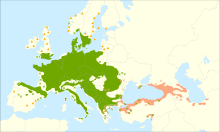| Part of a series on |
| Indo-European topics |
|---|
 |
The beech argument (German: Buchenargument) is a now mostly outdated argument in Indo-European studies that is in favour of placing the Indo-European urheimat in an area west of a line connecting Kaliningrad and the Black Sea, based on the current distribution of beech trees.[1][2] The argument, as summarised by Friedrich and Mallory goes that the Indo-European term *bʰāg(ó) most probably refers to the beech tree. Hence the presence of descendants of the term *bʰāg(ó) in Italic, Germanic, Albanian, Greek and (Indo-)Iranian, and potentially Celtic, Slavic, and Baltic, indicates that this word belonged to the most widely-spoken Indo-European language. And thirdly that since the beech tree distribution was limited historically to the regions west of the Eurasian Steppe, this is where this language was spoken.[3][4]

However much like the salmon problem, this is now an outdated argument, based on many factors including that the historical distribution of the beech trees was historically different from that of today, with certain species potentially extending to the Don River or to the Caucasus, due to the beech being climatically sensitive, and that with the exception of the Kurdish buz, these words for beech are only found in Western Indo-European languages.[5]
- ^ Fisiak, Jacek (6 December 1996). Linguistic Reconstruction and Typology. De Gruyter Moyton. p. 188. ISBN 978-3-11-014905-0. Retrieved 15 June 2020.
- ^ "European Beech". European Forest Genetic Resources Program. Retrieved 15 June 2020.
- ^ Blažek, Václav (2002). "The 'beech'-argument — State-of-the-Art". Historische Sprachforschung / Historical Linguistics. 115 (2): 190–217. JSTOR 41289089.
- ^ Pereltsvaig, Asya; Lewis, Martin (29 April 2015). The Indo-European Controversy: Facts and Fallacies in Historical Linguistics. Cambridge University Press. p. 186. ISBN 9781107054530. Retrieved 15 June 2020.
- ^ Pruthi, Raj (2004). Vedic Civilization. New Delhi: Discovery Publishing House. p. 31. ISBN 81-7141-875-9. Retrieved 15 June 2020.
